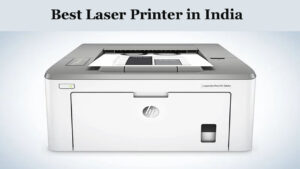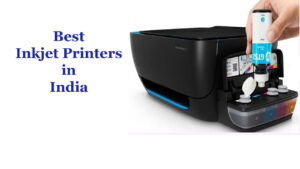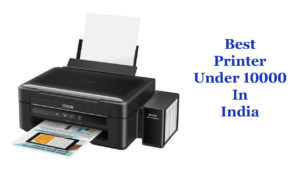An inkjet printer is a type of printer that prints text or images on paper or other materials using tiny droplets of ink. Inkjet printers work by spraying tiny droplets of ink onto paper via a series of tiny nozzles. Inkjet printer ink cartridges contain liquid ink that is sprayed through the nozzles in precise patterns to create text or images. Water, color pigments, and other chemicals enable ink to adhere to paper and dry quickly. At home, in offices, and in various industries, inkjet printers are commonly used to print documents and photographs. They are reasonably priced and produce high-quality prints with excellent color accuracy and sharpness. Additionally, inkjet printers can print on a variety of paper types and sizes, making them a versatile option for a variety of printing jobs.
Types of Inkjet printer
There are several types of inkjet printers, including
- Consumer-grade inkjet printers: Designed for home or small office use, these printers use inkjet technology. Documents, prints, and plates are generally published using them because they are relatively affordable.
- Business-grade inkjet printers: These printers are designed for larger services or workgroups and to handle advanced printing volumes. They’re frequently more precious than consumer-grade inkjet printers and can produce advanced-quality prints.
- Wide-format inkjet printers: These printers are designed for publishing large-format documents, similar to banners, bills, and arrangements. Large format documents are generally published in graphic design workrooms, engineering firms, and other disciplines.
- Portable inkjet printers: These are small and feather-light and designed for publishing on the go. Businesspeople, photographers, and other travellers who need to publish documents or prints regularly utilise them.
- All-in-one inkjet printers: These printers combine printing, scanning, copying, and occasionally faxing capabilities into a single device. They are typically employed in home services or small enterprises where their printer serves a number of purposes.
How to use an inkjet printer?
- Download and install the printer driver on your computer. The driver is often available for download from the manufacturer’s website or included on the printer’s CD.
- Utilize a USB cable to connect the printer to your computer, or connect it to your home network if it has wireless connectivity.
- Put paper into the printer’s paper tray.
- On your computer, open the file or image that needs to be printed, then select “Print” from the File menu.
- In the Print dialogue box, choose the printer you want to use and the print settings you want, such as print quality, paper size, and orientation.
- Remove the printed document from the printer’s output tray when the printing is finished.
- Track the stated instructions that came with your printer for any specific steps or requirements for your printer model.
Advantages of Inkjet Printer
- High-quality prints Inkjet printers can produce high-quality prints, particularly of photos and images. They use liquid essays, which can print with exact graphics and precise details in a variety of colours.
- Lower cost of entry Inkjet printers is generally less precious than ray printers, making them an excellent choice for budget-conscious home druggies and small businesses. They’re also less precious to maintain than ray printers.
- Compact size Inkjet printers are generally more compact than ray printers, which makes them easier to fit into small spaces. They’re good for home services, dorm apartments, or other small workspaces.
- Versatility Inkjet printers are adaptable and can publish on a wide range of paper types and sizes, including glossy print paper, cardstock, and fabrics. They can also publish on a variety of other accouterments, similar to CDs and DVDs.
- Lower energy consumption Inkjet printers consume lower power than ray printers, making them more environmentally friendly and cheaper to operate in the long run.
- Less noisy operating Inkjet printers are generally quieter than ray printers, which can be important in participating workspaces or homes.
Disadvantage of the Inkjet Printer
- The cost of essay Inkjet printers can be precious, especially if you use them constantly or for high-volume printing. The cost of essay charges can add up snappily and may be more precious per runner than other types of printers.
- Publish speed Inkjet printers are generally slower than ray printers, which can be a disadvantage if you need to publish many runners snappily.
- Although inkjet printers can produce high-quality images, ray printers may be sharper and more precise. They’re also more susceptible to smirching or bleeding, especially if you publish on glossy or print paper.
- Conservation Inkjet printers may bear further conservation than other types of printers. The essay snoots can come clogged or dried out if the printer is used sparingly, and the printer may need to be gutted or calibrated periodically to maintain optimal print quality.
- Continuity-published documents produced by inkjet printers may not be as durable as those produced by ray printers. An essay may fade or smirch over time, especially if the document is exposed to humidity or sun.
- Capacity Inkjet printers may have a different paper capacity than ray printers, which can be a disadvantage if you need to publish a large volume of documents at formerly.
Difference between Laser and Inkjet Printers
- Printing Technology The most abecedarian difference between ray and inkjet printers is the technology they use to publish. Ray printers use color-grease paint to produce images on paper, while inkjet printers use liquid essays. Numerous aspects of printer performance are impacted by this abercedarian variance in publishing technology.
- Print Speed Ray printers are faster than inkjet printers, particularly when publishing large textbook volumes. Ray printers can publish up to 50 runners per nanosecond (ppm), while inkjet printers generally publish around 15 ppm. Still, the print speed of an inkjet printer can vary depending on the specific model.
- Print excellence When publishing images, inkjet printers are typically better at producing high-quality colour prints. Ray printers can produce good-quality textbooks and simple plates but may need to be more suitable to match inkjet printers’ color delicacy and resolution.
- Cost Inkjet printers are cheaper than ray printers, particularly for home or small office use. Still, the cost of essay charges can add up snappily and may be more precious per runner than ray color charges.
- Conservation Inkjet printers are more energy-efficient than laser printers, especially when it comes to preventing dry or clogged essay charges. Ray printers are often more durable and require less frequent maintenance, while they occasionally require cleaning or colour cartridge replacement.
Conclusion
Overall, home drug users, academics, and small enterprises who need to publish high-quality documents and photographs without spending a lot of money on a printer or conservation should use inkjet printers. However, it’s important to consider your printing requirements and budget when choosing a printer and to weigh the pros & cons of each type of printer before making a purchase.
The word “inkjet printer” refers to a printer built in the 20th century for use unrelated to digital textile printing. Instead, the inkjet printer creates an image by adding essay drops onto a specific face, similar to paper, plastic, or fabric.
These microscopic drops of ink, which in the periphery are as small as 50 microns, have the ability to flawlessly build intricate images and publish any photograph. There are different types of inkjet printers, each producing the driblets of essays differently, but they all partake in many parallels that make them incredibly popular. The Inkjet printer enables quick and accurate results thanks to the size of the essay drops and the capability to mix different colors to reach any shade.



